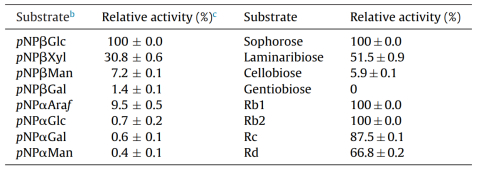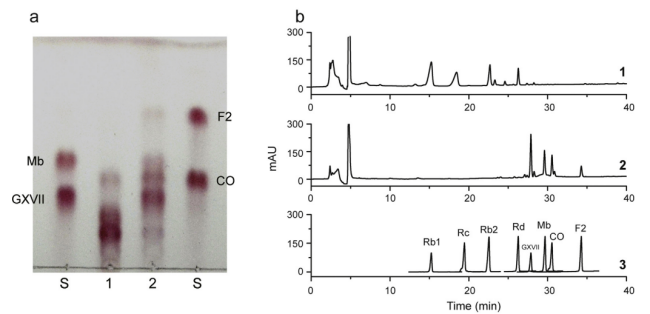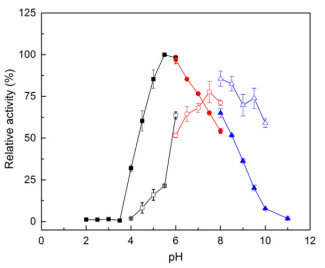CcGlu1A (exo-β-1,2-Glucosidase,CcBgl1A)
CcGlu1A (CcBgl1A)
Ex-Glu0007
(EC.3.2.1.115)exo-β-1,2-Glucosidase
CAZy Family: GH1
PROPERTIES
1.ELECTROPHORETIC PURITY
-Single band on SDS-gel electrophoresis (MW ~46 kDa)

Figure 1. Electrophoresis analysis of CcGlu1A. M, molecular weight marker (PageRuler Prestained Protein Ladder, Thermo Scientific); lane 1, culture lysate before IPTG induction; lane 2, culture lysate of after IPTG induction; lane 3, CcGlu1A purified from Ni sepharose fastflow column.
2.SPECIFIC ACTIVITY
31.5 U/mg protein (on pNP-β-glu) at pH 6.0 and 30°C
One Unit of pNP-β-glu activity is defined as the amount of enzyme required to release 1 μmol of glucose per minute from pNP-β-glu (5 mM) in phosphate buffer(50 mM) pH 6.0.
3.RELATIVE RATES OF HYDROLYSIS OF SUBSTRATES
Table 1. Relative activity of CcGlu1A on different substratesa.

aReactions were performed with 1 mM (p-nitrophenyl glycosides and disaccharides) or 5 mg/ml (polysaccharides) substrate, pH 6.0, at 30oC for 10 min.
bAbsorption caused by released p-nitrophenol or reducing sugars was measured at 405 or 520 nm. Thehydrolysis product of ginsenosides wasmeasured by HPLC. The relative activity on pNP-Glc (31.5 μmol/min/mg), sophorose (19.3 μmol/min/mg) and ginsenoside Rb1 (7.5 μmol/min/mg) was taken as 100%, respectively.
cThe data are reported as means ± standard errors from the mean for three independent experiments.

Fig. 2. Analysis of ginsenosidase activity of CcBgl1A on PPDGM by TLC (a) and HPLC (b). (a): 1, biotransformation substrate PPDGM; 2, transformed products of PPDGM; S, standards; (b): 1, biotransformation substrate PPDGM; 2, transformed products of PPDGM; 3, standards [1].
4.PHYSICOCHEMICAL PROPERTIES
pH Optima: 5.5
pH Stability: 6.0-10.0
Temperature Optima: 35°C
Temperature Stability:<30°C

Fig. 3. Effect of pH on activity (solid symbols) and stability (hollow symbols) of CcGlu1A. The optimal pH of CcBgl1A was determined by ranging pH from 2.0 to 11.0 using following buffers: sodium acetate buffer, pH 2.0–6.0; Na2HPO4–NaH2PO4 buffer, pH 6.0–8.0; Glycine–NaOH buffer, pH 8.0–11.0. The maximum activity obtained was defined as 100%. The pH stability of CcGlu1A was determined by pre-incubating CcGlu1A in different pH for 24 h at 4 ◦C and then determining the percentage of residual activity under standard assay conditions. The activity of CcGlu1A without pre-incubating was defined as 100%. Results are presented as means ± standard deviations (n = 3).

Fig. 4. Effect of temperature on activity (a) and stability (b) ofCcGlu1Ausing pNP-Glu as substrate. The optimal temperature (a) was determined at different temperatures from 20 to 80 ◦C. The maximum activity obtained was defined as 100% activity. Thermal stability was determined by incubating the enzyme for 1 h at different temperatures. The activity of the enzyme before incubation was defined as 100%. Results are presented as means ± standard deviations(n = 3).
5.STORAGE CONDITIONS
The enzyme should be stored at -20°C. For assay, this enzyme should be diluted in phosphate buffer (50 mM) pH 6.0. Swirl to mix the enzyme immediately prior to use.
6. REFERENCES
[1] Yuan Y, Hu Y B, Hu C X, et al. Overexpression and characterization of a glycoside hydrolase family 1 enzyme from Cellulosimicrobium cellulans sp. 21 and its application for minor ginsenosides production[J]. Journal of Molecular Catalysis B: Enzymatic, 2015, 120: 60-67.


